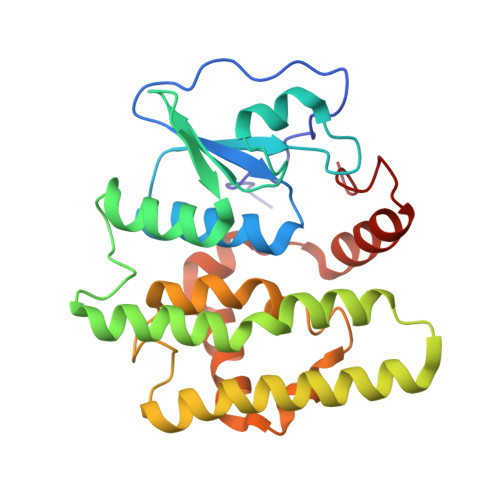Structure-Based Design of N-(5-Phenylthiazol-2-yl)acrylamides as Novel and Potent Glutathione S-Transferase Omega 1 Inhibitors.
Dai, W., Samanta, S., Xue, D., Petrunak, E.M., Stuckey, J.A., Han, Y., Sun, D., Wu, Y., Neamati, N.(2019) J Med Chem 62: 3068-3087
- PubMed: 30735370
- DOI: https://doi.org/10.1021/acs.jmedchem.8b01960
- Primary Citation of Related Structures:
6MHB, 6MHC, 6MHD - PubMed Abstract:
Using reported glutathione S-transferase omega 1 (GSTO1-1) cocrystal structures, we designed and synthesized acrylamide-containing compounds that covalently bind to Cys32 on the catalytic site. Starting from a thiazole derivative 10 (GSTO1-1 IC 50 = 0.6 μM), compound 18 was synthesized and cocrystallized with GSTO1. Modification on the amide moiety of hit compound 10 significantly increased the GSTO1-1 inhibitory potency. We solved the cocrystal structures of new derivatives, 37 and 44, bearing an amide side chain bound to GSTO1. These new structures showed a reorientation of the phenyl thiazole core of inhibitors, 37 and 44, when compared to 18. Guided by the cocrystal structure of GSTO1:44, analogue 49 was designed, resulting in the most potent GSTO1-1 inhibitor (IC 50 = 0.22 ± 0.02 nM) known to date. We believe that our data will form the basis for future studies of developing GSTO1-1 as a new drug target for cancer therapy.
Organizational Affiliation:
Key Laboratory of Drug Targeting and Drug Delivery System of Ministry of Education, West China School of Pharmacy , Sichuan University , No. 17 People's South Road , Chengdu 610041 , P. R. China.

















